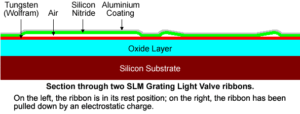Sony’s licensing of Silicon Light Machine’s Grating Light Valve (GLV) technology means that it may not be too long before TI’s DMD loses its place as the only Micro-Electro-Mechanical System (MEMS) to be used in projection.
Like the DMD, the GLV is a digital, reflective technology in which parts of the device are physically moved to alter the path of light shining on the chip’s surface. Unlike the DMD, however, pixels in a GLV reflect light only in their “off” state. In their “on” state, they diffract light in much the same way as does the recorded surface of a CD.
A pixel in a GLV array consists of a number of aluminium-coated ribbons, each about 100µm long, 100nm thick and typically about 3µm wide, suspended over a thin air gap. Each ribbon can be pulled down a controlled distance into the air gap by means of an electrostatic charge. When all the ribbons in a pixel are in their rest state, their aluminium coatings act as a mirror, reflecting light away from the projector’s optical path. If alternate ribbons in a pixel are pulled down, a square-well diffraction grating is formed in which each well is a fraction of the wavelength of light deep. Light waves reflecting off adjacent “up” and “down” ribbons are therefore out of phase with each other, different wavelengths by differing amounts. This causes the waves to interact in a way which causes each frequency of light to radiate from the pixel at a different angle. By varying the width, separation and degree of pull-down of the ribbons in each pixel, the angle at which certain frequencies, and therefore colours, of light radiate can be altered so that only a single colour is directed into the optical path.

The switching between two states of a GLV ribbon takes about 20 nanoseconds, about 1,000 times faster than a DMD’s mirror switches state, allowing SLM to develop a variant called the Scanned Linear GLV (SLGLV) consisting of just a single column of pixels. In an SLGLV projector, each column of the picture is displayed sequentially, from left to right across the screen. This is done so quickly, that the device has time to display the same image three or four times during a conventional video frame. As the amount of light projected for each screen pixel can be varied in each sub-frame, the SLGLV can take advantage of “temporal dithering” to effectively display extra bits of colour information. As the number of columns that are projected for a single frame can be determined electronically, the SLGLV also has the advantage of being an inherently multi-format device. Add to these attributes a claimed contrast ratio of better than 1,000:1 and 95% light-usage efficiency and it’s not hard to see why Sony has licensed the SLGLV for use in a laser-illuminated projector.
Update: Sony continues to work on the GLV approach using laser illumination and the writer saw a sample of the projector in Japan a couple of years ago at Sony’s demonstration suite. A similar approach to the GLV is used by the iMod display, invented by Iridigm, which was bought and is being commercialised by Qualcomm.

